Impacts of Social Innovation on Spatiality in Mountain–Lowland Relationships — Trajectories of Two Swiss Regional Initiatives in the Context of New Policy Regimes
Abstract
1. Introduction: The Ambiguous Character of SI
2. Social Innovation as a Creator of Spatiality
2.1. The Paradigm Shift in Accumulation and Distribution with Its Territorial Implications
2.2. Adaptive Versus Transformative SI
3. Rationale and Methods
4. Territorial Relations in Switzerland
5. Results of the Semi-Structured Interviews: Positive Impacts of the SI Initiatives
6. Results of the SNA: Strengthened Ties among Actors of the SI Initiatives
6.1. Val Lumnezia
6.2. Canton of Neuchâtel
7. Discussion of SI from the Perspective of Spatial Sustainable Development
7.1. What Is a Social Innovation?
7.2. Adaptive or Transformative?
7.3. Are the Swiss Cases Transferable?
7.4. Impacts of SI on the Changing Spatiality between Lowlands and Mountains, and Potential Transformations
8. Concluding Remarks
Institutional Review Board Statement
Informed Consent Statement
Data Availability Statement
Acknowledgments
Conflicts of Interest
Appendix A
| Six Types of Existing Social Innovation in the Alps | ||
|---|---|---|
| Type [with References] | Examples | Why It Is an SI |
| Contemporary forms of inherited uses of commons (Allmende/biens communaux) [62,63,64] | Alpine corporations, common municipality work with defined rights and obligations (like repairing watercourses) | As local institutions, they could prevent over- and underuse in territories difficult to cultivate. The challenge is to keep balancing of in- and exclusion of stakeholders for sustainable use. |
| New organisational and institutional arrangements for acquiring work, production, and jobs [65] | Producer‒consumer cooperatives; contract agriculture; common hotelling (Alberghi diffusi); commonly organised coworking residences, e.g., MiaEngiadina | The exchange between lowland and mountain populations is crucial to avoid large-scale segregation and deep cultural cleavages between territories. |
| Collective action with new institutional arrangements [66,67,68] | Community network Alliance in the Alps | Getting new knowledge by interregional and supranational cooperation and exchange. |
| Corrections of former environmental or societal malpractices [69] | Pesticide-free municipality of Mals/Val Venosta/IT; conversion to 100% organic agriculture in Val Poschiavo/CH | Polluted soils and waters are the most visible impacts of a liberal, productivist regime of accumulation. Solidarity practices to recreate natural resources are its counterpart. |
| Re-introducing or sustaining of old, approved techniques and skills [70,71,72] | New breweries to rebuild a value chain on barley; reconstructing chestnut forests; wool processing; cultivation of old plants and domesticated animals; enlargement of mountain dairies for urban food supply; maintenance of drystone walls | In the current productivist strategies, mountain areas are mainly regarded as landscapes to be valorised according to mainstream aesthetics. A more diverse economic spectrum should aim at preventing territorial cleavages in wealth and the overuse of ecologic resources. |
| Civic engagement against isolation, exclusion, and regional egoism [16,73,74,75,76,77,78,79,80] | Welcoming towards migrants and refugees (“welcoming culture”) | The inclusion of incomers raises the capacities of social interaction; local communities can benefit as well as migrants. Respecting human rights is currently not mainstream but sustainable. |
| Tool 2 Focus Group | Structured and Semi-Structured Interviews | Structured Interviews | |||||
| Tool 7 Internal to the Social Innovation | Tool 8 External Experts | Tool 3 Clique | Tool 7 Internal to the Social Innovation | Tool 8 External Experts | Tool 6 Beneficiaries | ||
| Members | ― | ― | ― | 5 | 13 | 2 | 2068 a |
| Sampling Requirements | ― | ― | ― | Judgement sampling | Census | Convenience sampling | Convenience sampling b |
| Sample Size | 7 | 4 | 3 | 1 | 10 | 1 | 6 |
| Interviewee Codes | LUM001 LUM006 LUM007 LUM010 LUM011 LUM012 LUM013 | LUM001 LUM004 LUM011 LUM012 | LUM004 c LUM011 c LUM012 c | LUM001 | LUM002 LUM003 LUM004 LUM005 LUM006 LUM007 LUM010 LUM011 LUM012 LUM016 | LUM001 | LUM023 LUM024 LUM025 LUM026 LUM027 LUM028 |
| Interviewee Code | Role in the Social Innovation | Profile |
| LUM001 | Innovator | Trade and crafts association |
| LUM002 | Follower | Trade and crafts association |
| LUM003 | Follower | Trade and crafts association |
| LUM004 | Follower | Architect |
| LUM005 | Follower | External consultant |
| LUM006 | Follower | External consultant |
| LUM007 | Follower | Environmental NGO |
| LUM010 | Follower | President of district Lumnezia and village major |
| LUM011 | Follower | Regional and national politician |
| LUM012 | Transformer | Village major and local politician |
| LUM013 | Transformer | Director tourism and tourism consultant |
| LUM016 | Transformer | Regional politician |
| LUM023 | Beneficiary | Village major, farmer |
| LUM024 | Beneficiary | Regional politician |
| LUM025 | Beneficiary | Independent entrepreneur (artisan) |
| LUM026 | Beneficiary | Farmer |
| LUM027 | Beneficiary | Land register administrator |
| LUM028 | Beneficiary | Independent entrepreneur (construction) |
| TOTAL | 18 |
| Tool 2 Focus Group | Structured and Semi-Structured Interviews | Structured Interviews | |||||
| Tool 7 Internal to the Social Innovation | Tool 8 External Experts | Tool 3 Clique | Tool 4 Network | Tool 5 Project Partners | Tool 6 Beneficiaries | ||
| Members | ― | ― | ― | 6 a | 95 a | 15 a | 11898 b |
| Sampling Requirements | ― | ― | ― | Convenience sampling c | Convenience sampling d | Convenience sampling e | Convenience sampling e |
| Sample Size | 5 | 2 | 1 | 2 | 4 | 2 | 2 |
| Interviewee Codes | FLE001 FLE003 FLE004FLE006 FLE0019 | FLE002 FLE004 | FLE020 | FLE002 FLE004 | FLE003 FLE005 FLE006 FLE007 | FLE001 FLE008 | FLE017 FLE018 |
| Interviewee Code | Role in the Social Innovation | Profile |
| FLE001 | Transformer/Project Partner | Politician and part of the administration of Val-de-Travers |
| FLE002 | Innovator | Former chief officer in the cantonal administration |
| FLE003 | Follower | Project manager |
| FLE004 | Innovator | Cantonal executive politician. Main initiator together with FLE002 |
| FLE005 | Follower | Member of a local municipality council |
| FLE006 | Transformer | Member of Réseau des Fleurons, CEO of a manufacturing enterprise |
| FLE007 | Mainstreamer | Administrator of a municipality that did not merge |
| FLE008 | Project Partner | Politician, part of the administration of the merged municipality |
| FLE017 | Beneficiary | Citizen of Val-de-Travers, member of cantonal parliament |
| FLE018 | Beneficiary | Management of enterprise of Réseau des Fleurons |
| FLE019 | Follower /Project Partner | Project manager at RUN |
| FLE020 | Policy Expert | Academic |
| TOTAL | 12 |
References
- Ravazzoli, E.; Dalla Torre, C.; Da Re, R.; Marini Govigli, V.; Secco, L.; Górriz-Mifsud, E.; Pisani, E.; Barlagne, C.; Baselice, A.; Bengoumi, M.; et al. Can social innovation make a change in European and Mediterranean marginalized areas? Social innovation impact assessment in agriculture, fisheries, forestry, and rural development. Sustainability 2021, 13, 1283. Available online: https://www.mdpi.com/2071-1050/13/4/1823 (accessed on 15 March 2021). [CrossRef]
- Davezies, L. Le Nouvel Égoïsme Territorial. Le Grand Malaise des Nations; Seuil: Paris, France, 2015. [Google Scholar]
- Schumpeter, J.A. Capitalism, Socialism and Democracy; Harper: New York, NY, USA, 1975 [1942]. [Google Scholar]
- Urban, B.; Hobbs, J. Nando’s Chilli Sourcing: Innovation for Social Impact; Sage: London, UK, 2015. [Google Scholar]
- Yunus, M.; Moingeon, B.; Lehmann-Ortega, L. Building Social Business Models Lessons from the Grameen Experience. Long Range Plan. 2010, 43, 308–325. [Google Scholar] [CrossRef]
- Schuler, M.; Perlik, M.; Pasche, N. Non-Urbain, Campagne ou Périphérie—Où se Trouve l’Espace Rural Aujourd’hui? Office fédéral du développement territorial (ARE): Ittigen, Switzerland, 2004.
- Fujita, M.; Krugman, P.; Venables, A. The Spatial Economy: Cities, Regions and International Trade; MIT Press: Cambridge, MA, USA, 1999. [Google Scholar]
- Krugman, P. Geography and Trade; MIT Press: Cambridge, MA, USA, 1991. [Google Scholar]
- Sheppard, E. The Spatiality of The Limits to Capital. Antipode 2004, 36. [Google Scholar] [CrossRef]
- Manow, P. Die Politische Ökonomie des Populismus (The Political Economy of Populism); Suhrkamp: Berlin, Germany, 2018. [Google Scholar]
- Rodríguez-Pose, A. The revenge of the places that don’t matter (and what to do about it). Camb. J. Reg. Econ. Soc. 2017, 11, 189–209. [Google Scholar] [CrossRef]
- UN Transforming Our World. The 2030 Agenda for Sustainable Development; United Nations: New York, NY, USA, 2015. [Google Scholar]
- Hu, X.; Hassink, R. Adaptation, adaptability and regional economic resilience: A conceptual framework. In Handbook on Regional Resilience; Bristow, G., Healy, A., Eds.; Edward Elgar: Cheltenham, UK, 2019; p. 512. [Google Scholar]
- Fourny, M.-C. Périphérique, forcément périphérique? La montagne au prisme de l’analyse géographique de l’innovation. In Innovation en Territoire de Montagne le Défi de l’Approche Interdisciplinaire, Montagne et Innovation; Attali, M., Granet-Abisset, A.-M., Dalmasso, A., Eds.; PUG: Grenoble, France, 2014; p. 224. [Google Scholar]
- Tschumi, P.; Winiger, A.; Wirth, S.; Mayer, H.; Seidl, I. Wachstumsunabhängigkeit durch Soziale Innovationen? Eine Analyse potenzieller Wachstumswirkungen von Sozialen Innovationen im Schweizer Berggebiet. In Postwachstumsgeographien Raumbezüge Diverser und Alternativer Ökonomien, Sozial- und Kulturgeographie; Lange, B., Hülz, M., Schmid, B., Schulz, C., Eds.; Transcript: Bielefeld, Germany, 2020; Volume 38, p. 456. [Google Scholar]
- Perlik, M.; Membretti, A. Migration by Necessity and by Force to Mountain Areas: An Opportunity for Social Innovation. MRD 2018, 38, 250–264. Available online: https://bioone.org/journals/mountain-research-and-development/volume-38/issue-3/MRD-JOURNAL-D-17-00070.1/Migration-by-Necessity-and-by-Force-to-Mountain-Areas/10.1659/MRD-JOURNAL-D-17-00070.1.full (accessed on 15 March 2021). [CrossRef]
- BEPA, Bureau of European Policy Advisers. Social Innovation: A Decade of Changes; European Commission: Luxembourg, 2014. [Google Scholar]
- EC, DG Employment, Social Affairs and Inclusion. Social Economy and Social Entrepreneurship. Social Europe Guide 4; European Commission: Luxembourg, 2013. [Google Scholar]
- EC, DG Research and Innovation Socio-economic Sciences and Humanities. Social Innovation Research in the European Union. Approaches, Findings and Future Directions. Policy Review; European Commission: Brussels, Belgium, 2013. [Google Scholar]
- EC, DG Regional and Urban Policy and DG Employment, Social Affairs and Inclusion. Guide to Social Innovation; European Commission: Brussels, Belgium, 2013. [Google Scholar]
- Bürgin, R.; Mayer, H. Digital periphery? A community case study of digitalization efforts in Swiss mountain regions. In Smart Village Technology. Concepts and Developments. Modeling and Optimization in Science and Technologies; Patnaik, S., Sen, S., Mahmoud, M.S., Eds.; Springer: Berlin, Germany, 2020; Volume 17, p. 436. [Google Scholar]
- Andrew, C.; Klein, J.-L. Social Innovation: What Is It and Why Is It Important to Understand It Better; Collection Etudes théoriques 1003; CRISES: Montréal, QC, Canada, 2010. [Google Scholar]
- Avelino, F.; Wittmayer, J.; Pel, B.; Weaver, P.; Dumitru, A.; Haxeltine, A.; Kemp, R.; Jørgensen, M.; Bauler, T.; Ruijsink, S.; et al. Transformative social innovation and (dis)empowerment. Technol. Forecast. Soc. Chang. 2019, 145, 195–206. [Google Scholar] [CrossRef]
- Avelino, F.; Dumitru, A.; Cipolla, C.; Kunze, I.; Wittmayer, J. Translocal empowerment in transformative social innovation networks. Eur. Plan. Stud. 2020, 28, 955–977. [Google Scholar] [CrossRef]
- Klein, J.-L.; Laville, J.-L.; Moulaert, F. (Eds.) L’Innovation Sociale; ERÈS: Toulouse, France, 2014. [Google Scholar]
- Landel, P.-A.; Koop, K.; Senil, N. Quand l’innovation sociale change la dynamique des territoires de montagne. In Montagnes en Mouvements. Dynamiques Territoriales et Innovation Sociale, Montagne et Innovation; Fourny, M.-C., Ed.; PUG: Grenoble, France, 2018; p. 219. [Google Scholar]
- Moulaert, F.; Martinelli, F.; Swyngedouw, E.; González, S.G. Towards alternative model(s) of local innovation. Urban Stud. 2005, 42, 1969–1990. [Google Scholar] [CrossRef]
- Moulaert, F.; Mehmood, A. Spaces of social innovation. In Handbook of Local and Regional Development; Pike, A., Rodriguez-Pose, A., Tomaney, J., Eds.; Routledge: London, UK, 2011; p. 664. [Google Scholar]
- Moulaert, F.; Mehmood, A. Analysing regional development: From territorial innovation to path-dependent geography. In The Elgar Companion to Social Economics; Davis, J.B., Dolfsman, W., Eds.; Edward Elgar: Cheltenham, UK, 2015; p. 682. [Google Scholar]
- Moulaert, F.; Sekia, F. Territorial innovation models: A critical survey. Reg. Stud. 2003, 37, 289–302. [Google Scholar] [CrossRef]
- Perlik, M. Innovations sociales en montagne: Au-delà de l’ingénierie sociale, une véritable force transformatrice? In Montagnes en Mouvements. Dynamiques Territoriales et Innovation Sociale, Montagne et Innovation; Fourny, M.-C., Ed.; PUG: Grenoble, France, 2018; p. 219. [Google Scholar]
- MacCallum, D.; Vicari Haddock, S.; Moulaert, F. (Eds.) Social Innovation and Territorial Development; Routledge: London, UK, 2009. [Google Scholar]
- Swyngedouw, E. Civil Society, Governmentality and the Contradictions of Governance-beyond-the-State: The Janus-face of Social Innovation. In Social Innovation and Territorial Development; Maccallum, D., Vicari Haddock, S., Eds.; Routledge: London, UK, 2009; p. 188. [Google Scholar]
- Swyngedouw, E. From Disruption to Transformation: Politicisation at a Distance from the State. Antipode 2020, 53, 486–496. [Google Scholar] [CrossRef]
- TRANSIT (Transformative Social Innovation Theory). Available online: http://www.transitsocialinnovation.eu/briefs (accessed on 15 March 2021).
- Van den Broeck, P.; Mehmood, A.; Paidakaki, A.; Parra, C. (Eds.) Social Innovation as Political Transformation. Thoughts for a Better World; Edward Elgar: Cheltenham, UK, 2019. [Google Scholar]
- Secco, L.; Pisani, E.; Da Re, R.; Rogelja, T.; Burlando, C.; Vicentini, K.; Pettenella, D.; Masiero, M.; Miller, D.; Nijnjk, M. Towards a method of evaluating social innovation in forest-dependent rural communities. First suggestions from a science-stakeholder collaboration. For. Policy Econ. 2019, 104, 9–22. [Google Scholar] [CrossRef]
- Perlik, M.; Wissen, U.; Schuler, M.; Hofschreuder, J.; Jarne, A.; Keiner, M.; Cavens, D.; Schmid, W.A. Szenarien für die nachhaltige Siedlungs- und Infrastrukturentwicklung in der Schweiz (2005–2030). Report for the Swiss National Science Foundation (SNSF). In The Framework of National Research Programme 54 “Sustainable Development of the Built Environment”; ETHZ: Zurich, Switzerland, 2008. [Google Scholar]
- Schuler, M.; Perlik, M. Regionale Disparitäten. In Schweiz—Geographie, Geschichte, Wirtschaft, Politik; Schneider-Sliwa, R., Ed.; WBG: Darmstadt, Germany, 2011; p. 228. [Google Scholar]
- Stucki, E.W.; Roque, O.; Schuler, M.; Perlik, M. Contents and Impacts of Mountain Policies, Switzerland. National Report for the Study Analysis of Mountain Areas in the European Union and in the Applicant Countries; Federal Department of Economic Affairs (seco): Berne, Switzerland, 2004. [Google Scholar]
- Diener, R.; Herzog, J.; Meili, M.; de Meuron, P.; Schmid, C. Switzerland: An Urban Portrait; ETH: Zurich, Switzerland; Birkhäuser: Basel, Switzerland, 2006. [Google Scholar]
- Crevoisier, O.; Jeannerat, H.; Scherer, R.; Zumbusch, K. Neue Regionalpolitik und Privatwirtschaftliche Initiative. Final Report; Université de Neuchâtel: Neuchatel, Switzerland; Universität St. Gallen: St. Gallen, Switzerland, 2011. [Google Scholar]
- Expertenkommission “Überprüfung und Neukonzeption der Regionalpolitik”. Neue Regionalpolitik (NRP). Final Report; Federal Department of Economic Affairs (seco): Berne, Switzerland, 2003. [Google Scholar]
- Schweizerischer Bundesrat. Botschaft über die Neue Regionalpolitik (NRP) vom 16. November 2005. Available online: https://www.fedlex.admin.ch/eli/fga/2006/7/de (accessed on 15 March 2021).
- Hadjimichalis, C. The End of Third Italy As We Knew It? Antipode 2006, 38, 82–106. [Google Scholar] [CrossRef]
- ARE. Projet de Territoire Suisse; ARE: Berne, Switzerland, 2011. [Google Scholar]
- Cavelti, G.; Kopainsky, B.; Strategien zum Umgang mit potenzialarmen Räumen. Erarbeitet am Beispiel der Kantone Graubünden und Uri (Bericht Graubünden). 2008. Available online: https://regiosuisse.ch/sites/default/files/2016-08/studie-potenzialarme-raeume.pdf (accessed on 15 March 2021).
- Kopainsky, B.; Cavelti, G.; Giuliani, G. Umgang mit schwachen Räumen. Instrumente und Erfahrungen in den Mitgliedsländern der Arbeitsgemeinschaft Alpenländer Arge Alp. 2007. Available online: https://flurygiuliani.files.wordpress.com/2015/06/k2-potenzialarme-rc3a4ume.pdf (accessed on 15 March 2021).
- Meier, R.; SAB. Groupement suisse pour les regions de montagne Angepasster Tourismus—Entwicklung und Aussichten für das Oberlugnez, Kanton Graubünden. In Schriftenreihe der SAB 122; SAB: Berne, Switzerland, 1986. [Google Scholar]
- SAB, Groupement suisse pour les régions de montagne. Les Régions de Montagne Suisses. Faits et chiffres. Several Years. Available online: www.sab.ch/fileadmin/user_upload/customers/sab/Dokumente/Publikationen_SAB/Schweizer_Berggebiet_2016_Internet.pdf (accessed on 15 March 2021).
- SAB, Groupement suisse pour les régions de montagne. Potenzialarme Räume: Analyse von Fallbeispielen; SAB: Berne, Switzerland, 2013. [Google Scholar]
- Marini Govigli, V.; Perlik, M.; Herrmann, P. Analytical Case Studies (Case Study Type A) Pro Val Lumnezia—Surselva, Canton of Grisons/Switzerland (SAB-UNIBE). Report 5.4b—Social Innovation in Marginalised Rural Areas (SIMRA). 2019. Available online: https://www.researchgate.net/publication/350072616_Analytical_Case_Studies_Case_Study_Type_A_Pro_Val_Lumnezia_-_Surselva_Canton_of_GrisonsSwitzerland_UNIBECDE_SAB_Report_54b_-_Social_Innovation_in_Marginalised_Rural_Areas_SIMRA (accessed on 15 March 2021).
- Marini Govigli, V.; Perlik, M.; Koch, A. Analytical-Informational Case Studies (Case Study Type B) Réseau Urbain Neuchâtelois (UNIBE/CDE & SAB). Report 5.4l. Social Innovation in Marginalised Rural Areas (SIMRA). 2019. Available online: https://www.researchgate.net/publication/350074362_Analytical-_Informational_Case_Studies_Case_Study_Type_B_Reseau_Urbain_Neuchatelois_SAB-UNIBE_Report_54l_-_Social_Innovation_in_Marginalised_Rural_Areas_SIMRA_pp_68 (accessed on 15 March 2021).
- Kluvánková, T.; Nijnik, M.; Spacek, M.; Sarkki, S.; Perlik, M.; Lukesch, R.; Melnykovych, M.; Valero, D.; Brnkal’áková, S. Social innovation for sustainability transformation and its diverging development paths in marginalised rural areas. Soc. Rural. 2021. [Google Scholar] [CrossRef]
- Lukesch, R.; Ludvig, A.; Slee, B.; Weiss, G.; Živojinović, I. Social Innovation, Societal Change, and the Role of Policies. Sustainability 2020, 12, 7407. Available online: https://www.mdpi.com/2071-1050/12/18/7407 (accessed on 15 March 2021). [CrossRef]
- Agnew, J. The territorial trap: The geographical assumptions of international relations theory. Rev. Int. Political Econ. 1994, 1, 53–80. [Google Scholar] [CrossRef]
- Debarbieux, B.; Balsiger, J. Sustainable development and the concept of scale. In The Elgar Companion to Geography, Transdisciplinarity and Sustainability; Sarmiento, F.O., Frolich, L.M., Eds.; Edward Elgar: Cheltenham, UK, 2020; p. 448. [Google Scholar]
- Piketty, T. Capital in the Twenty-First Century; Belknap Press: Cambridge, MA, USA, 2014. [Google Scholar]
- Piketty, T. Capital and Ideology; HUP: Cambridge, MA, USA, 2020. [Google Scholar]
- Crevoisier, O.; Corpataux, J.; Thierstein, A. Intégration Monétaire et Régions: Des Gagnants et des Perdants; Harmattan: Paris, France, 2001. [Google Scholar]
- Perlik, M. The Spatial and economic transformation of mountain regions. Landscapes as commodities. In Routledge Advances in Regional Economics, Science and Policy; Routledge: London, UK, 2019. [Google Scholar]
- Haller, T.; Breu, T.; De Moor, T.; Rohr, C.; Znoj, H. (Eds.) The Commons in a Global World book. Global Connections and Local Responses; Routledge: London, UK, 2019. [Google Scholar]
- Niederer, A. Alpine Alltagskultur Zwischen Beharrung und Wandel. Ausgewählte Arbeiten aus den Jahren 1956–1991; Anderegg, K., Bätzing, W., Eds.; Haupt: Berne, Switzerland, 1993. [Google Scholar]
- Ostrom, E. Governing the Commons: The Evolution of Institutions for Collective Action; CUP: Cambridge, MA, USA, 1990. [Google Scholar]
- Rist, S.; Bürgi Bonanomi, E.; Giger, M.; Hett, C.; Scharrer, B.; Jacobi, J.; Lannen, A. Variety is the source of life: Agrobiodiversity benefits, challenges, and needs. In Swiss Academies Factsheets 15; Swiss Academy of Science: Berne, Switzerland, 2020. [Google Scholar]
- Balsiger, J. The Impact of Ecoregional Mobilization on Mountain Policies in the Swiss Alps and California’s Sierra Nevada. J. Alp. Res. 2009, 97. Available online: https://journals.openedition.org/rga/876 (accessed on 15 March 2021). [CrossRef][Green Version]
- Debarbieux, B. Preface: Mountain regions as referents for collective action. J. Alp. Res. 2009, 97. Available online: https://journals.openedition.org/rga/855 (accessed on 15 March 2021).
- Rudaz, G.; Territorial redefinition and the governance of mountain regions. J. Alp. Res. 2009, 97. Available online: https://journals.openedition.org/rga/866 (accessed on 15 March 2021).
- Wysling, A. Ein Dorf kämpft gegen die Agrochemie. Mals im Südtirol–die erste pestizidfreie Gemeinde Europas. NZZ (Neue Zürcher Zeitung), 3 October 2015; 11. [Google Scholar]
- Grison, J.-B.; Landel, P.-A. The Wool-Processing Industry in an Era of Social Innovation. How Has the Situation Changed in the Massif Central (France)? J. Alp. Res. 2019, 107. Available online: https://journals.openedition.org/rga/5982 (accessed on 15 March 2021). [CrossRef]
- Institutionelle Regime für nachhaltige Landschaftsentwicklung. Régimes Institutionnels pour le Développement Durable du Paysage; Rodewald, R., Knoepfel, P., Eds.; Ecologie & Société; Rüegger: Zurich, Switzerland, 2005; Volume 20. [Google Scholar]
- Varotto, M.; Bonardi, L.; Tarolli, P. (Eds.) World Terraced Landscapes: History, Environment, Quality of Life; Springer: Cham, Switzerland, 2019. [Google Scholar]
- Cretton, V.; The Mountain, Emblem of the Paradox of the Integration of Asylum Seekers in Switzerland. J. Alp. Res. 2020, 108. Available online: https://journals.openedition.org/rga/7027 (accessed on 15 March 2021).
- ForAlps (Foreign Immigration in the Alps). Available online: www.foralps.eu (accessed on 10 November 2019).
- Galera, G.; Giannetto, L.; Membretti, A.; Noya, A. Integration of migrants, refugees and asylum seekers in remote areas with declining populations. In OECD Local Economic and Employment Development (LEED) Working Papers, 2018/03; OECD: Paris, France, 2018. [Google Scholar]
- Graf, F. A Life Here and There: First-generation Migrants in the Grison Alps. In Alpine Refugees—Immigration at the Core of Europe; Perlik, M., Galera, G., Machold, I., Membretti, A., Eds.; CSP: Cambridge, MA, USA, 2019; p. 303. [Google Scholar]
- Gretter, A.; Machold, I.; Membretti, A.; Dax, T. Pathways of Immigration in the Alps and Carpathians: Social Innovation and the Creation of a Welcoming Culture. Mt. Res. Dev. 2017, 37, 396–405. Available online: https://bioone.org/journals/mountain-research-and-development/volume-37/issue-4/MRD-JOURNAL-D-17-00031.1/Pathways-of-Immigration-in-the-Alps-and-Carpathians--Social/10.1659/MRD-JOURNAL-D-17-00031.1.full (accessed on 15 March 2021). [CrossRef]
- MATILDE (Migration Impact Assessment to Enhance Integration and Local Development in European Rural and Mountain Areas). A Horizon 2020 Project. Available online: https://matilde-migration.eu/ (accessed on 1 December 2020).
- PlurAlps (Enhancing Capacities for a Pluralistic Alpine Space). An Alpine Space Project. Available online: https://www.alpine-space.eu/projects/pluralps/en/home (accessed on 1 December 2020).
- Semprebon, M. Promoting an Integrated Local Welfare System in an “Unwelcoming” Mountain Area: The Reception of Forced Migrants in Val Camonica. In Alpine Refugees—Immigration at the Core of Europe; Perlik, M., Galera, G., Machold, I., Membretti, A., Eds.; CSP: Cambridge, MA, USA, 2019; p. 303. [Google Scholar]
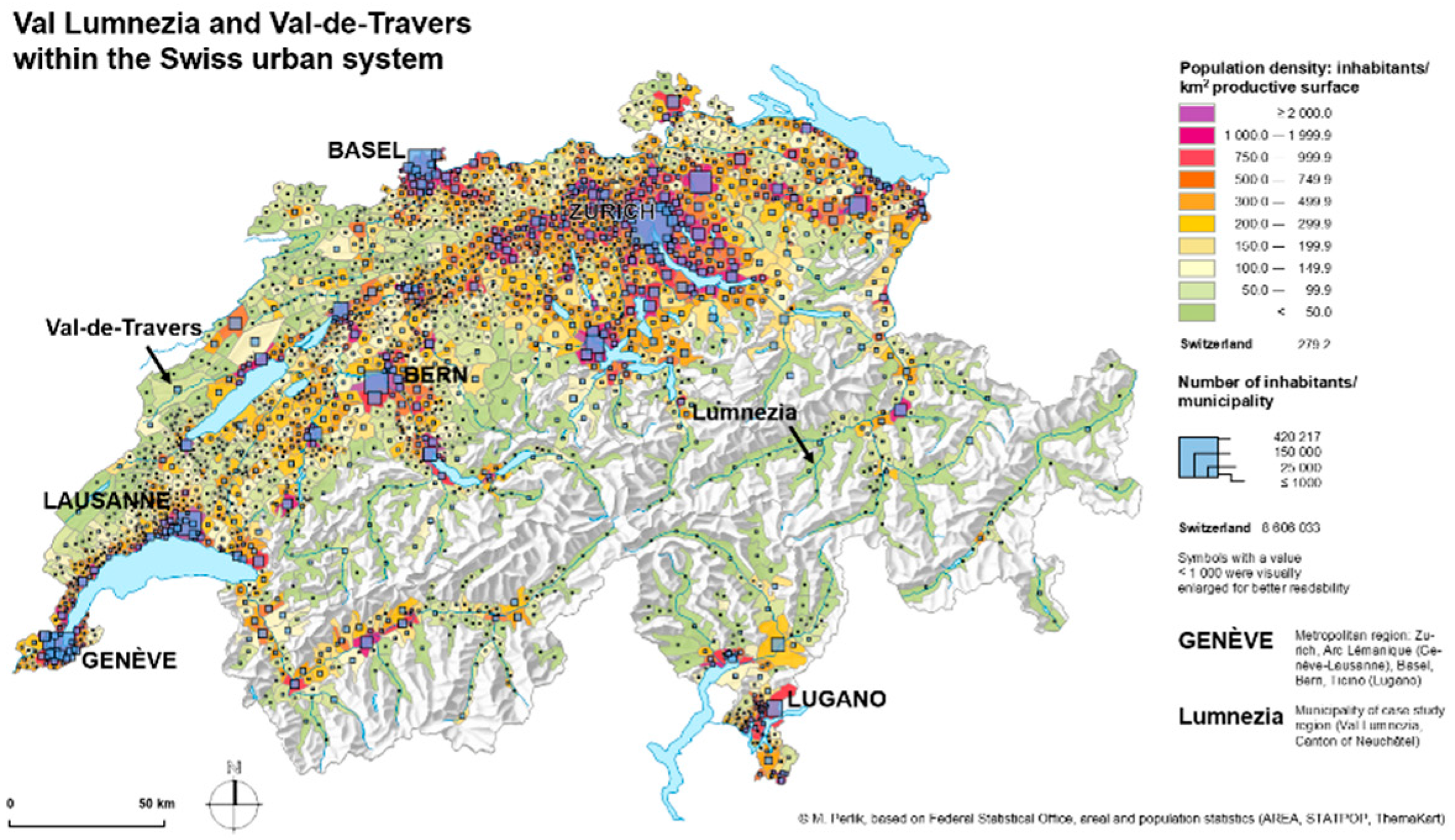
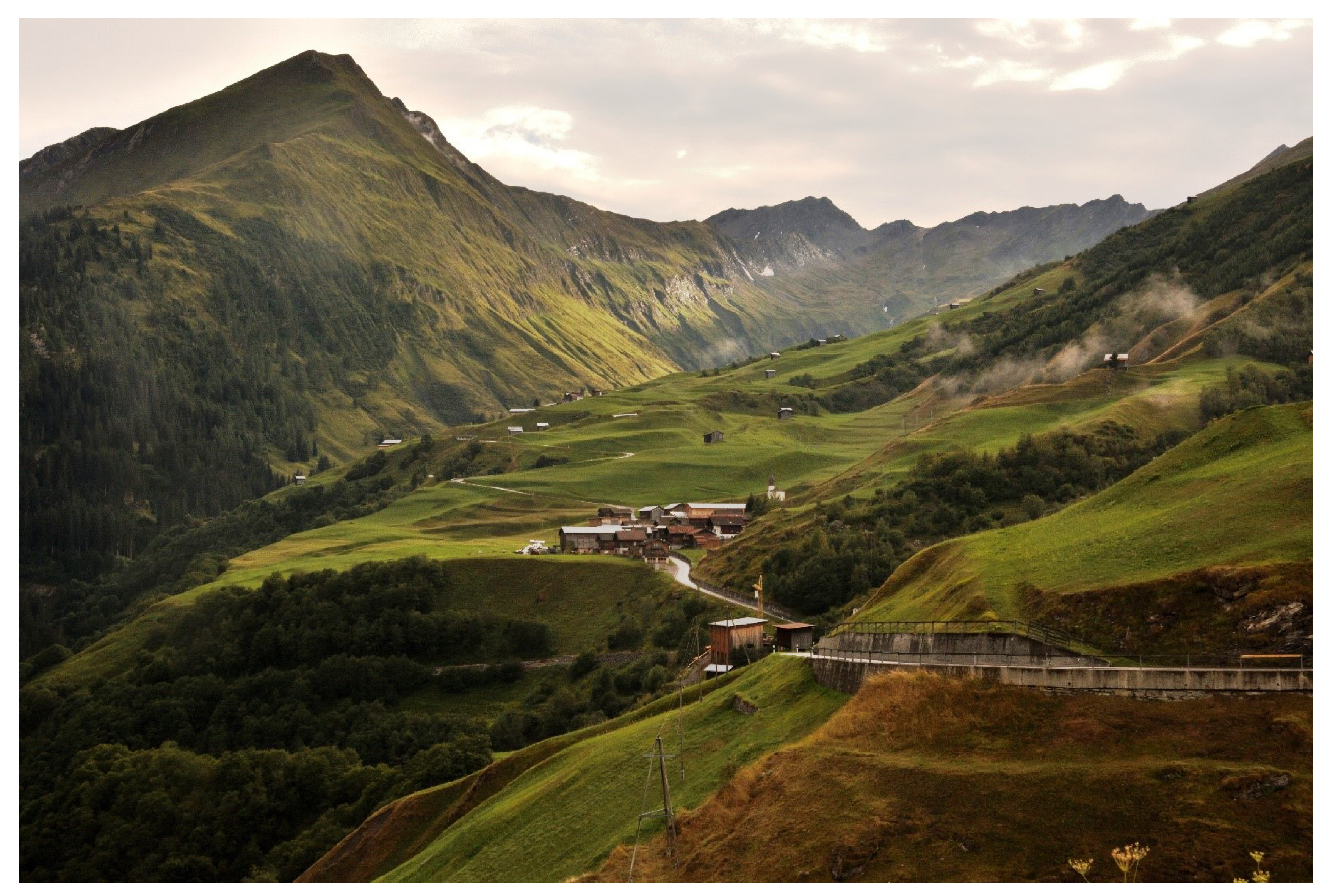

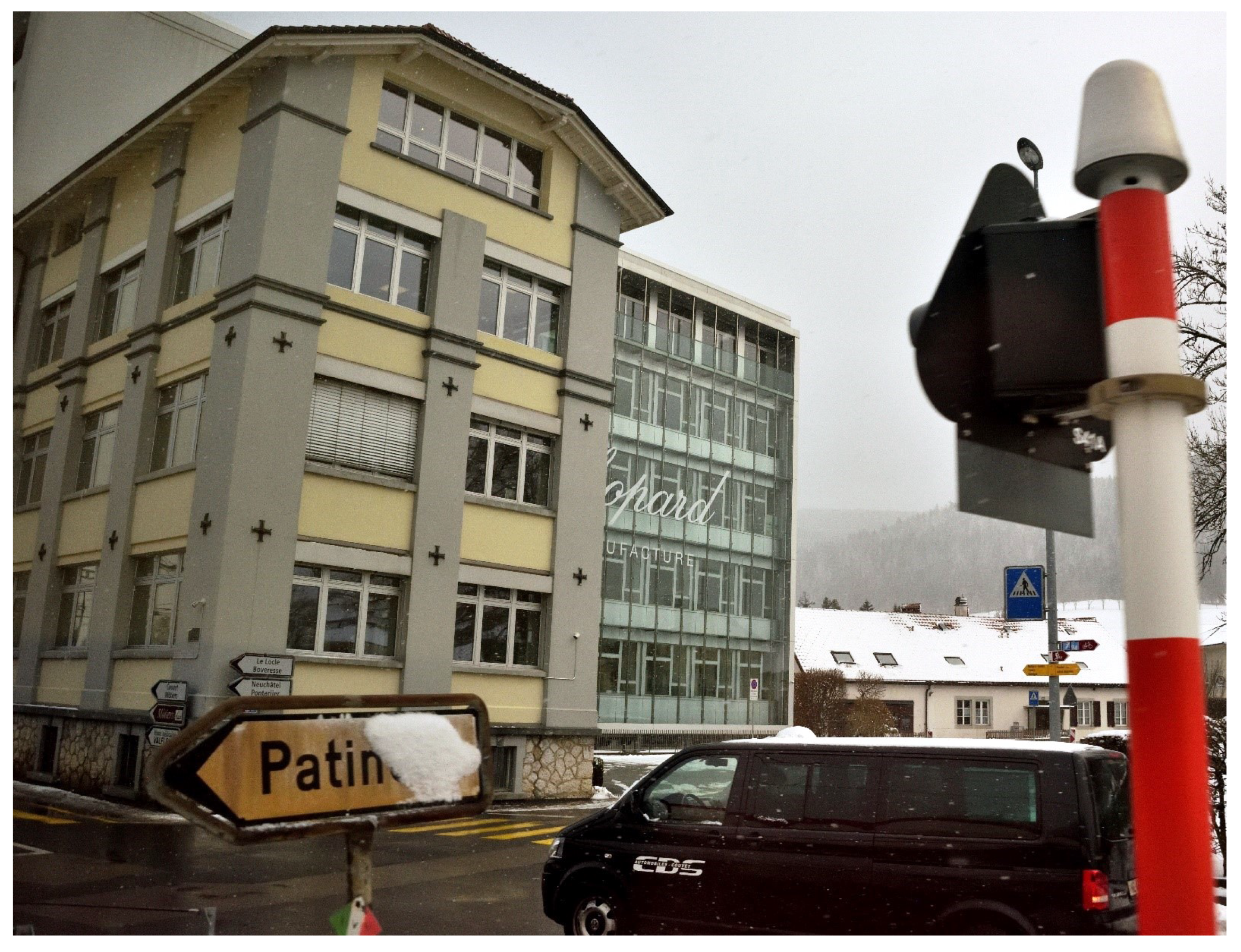

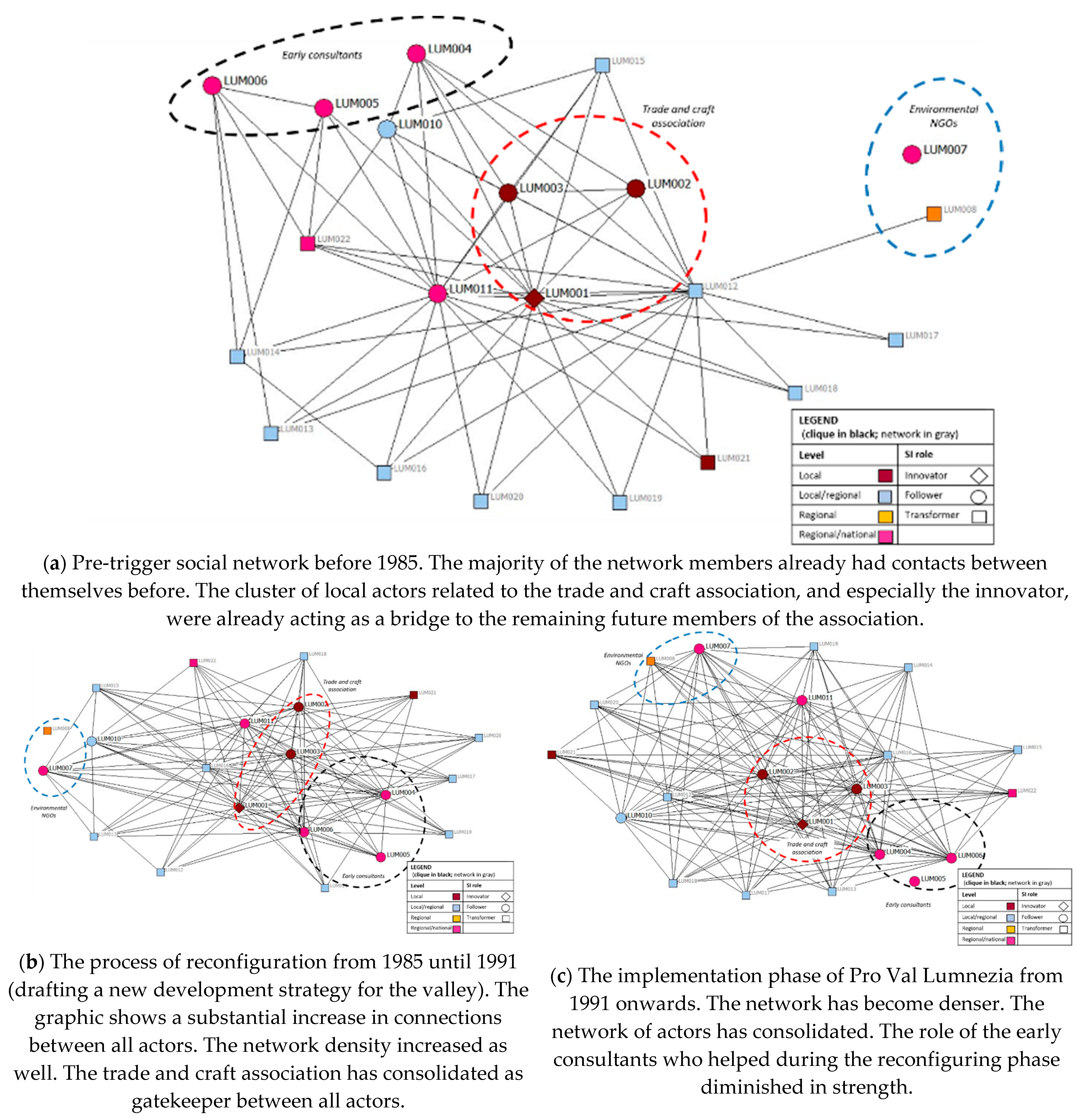
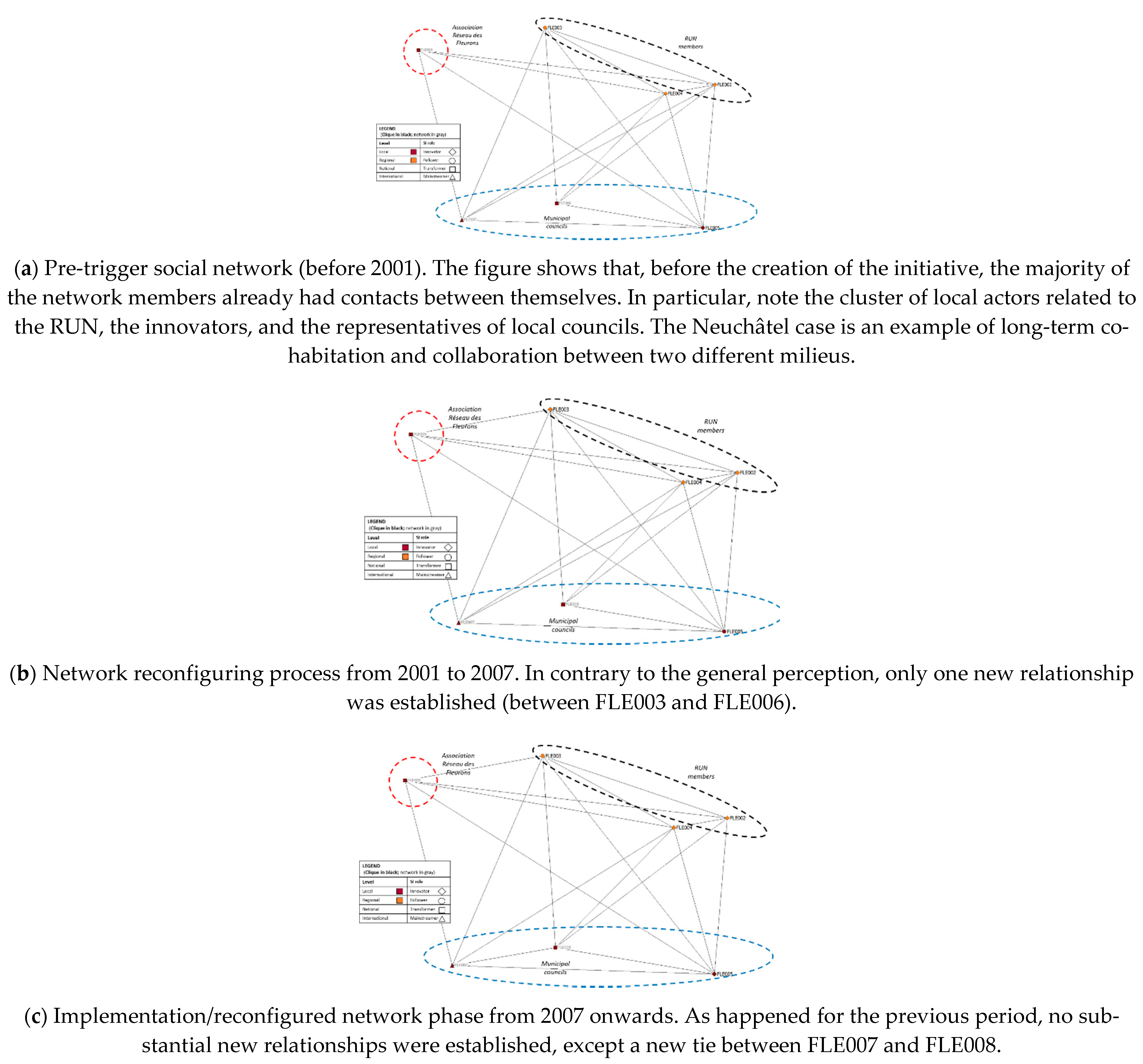
| Peripheral Valleys | 1970 | 1980 | 1990 | 2000 | 2010 | 2017 | 2018 | 1990–2018 |
| Lumnezia (11 villages merged) | 2527 | 2262 | 2254 | 2309 | 2216 | 2047 | 2026 | −10.1% |
| Val-de-Travers (9 communities merged) | 12,549 | 10,169 | 10,749 | 10,910 | 10,832 | 10,745 | 10,668 | −0.8% |
| Metropolitan | 1970 | 1980 | 1990 | 2000 | 2010 | 2017 | 2018 | 1990–2018 |
| City of Zurich | 422,640 | 361,441 | 347,634 | 334,298 | 372,047 | 407,447 | 413,912 | +19.1% |
| Domain | Elements | |
|---|---|---|
| Val Lumnezia | Canton of Neuchâtel/Val de Travers | |
| Economic | Infrastructural investments Creation of new economic and social activities “… I believe that prosperity has increased, I do believe that the farmers have increased their prosperity…” (LUM004) “…a few nice projects have been created…” (LUM004) “…some melioration took place and the hiking trails that nobody thought of, we came and said, we need the hiking trails, we have to create new ones…” (LUM001) | Creation of new economic and social activities Consolidation of existing activities’ network |
| Social | Community solidarity “…if you want to get ahead, you have to work together…” (LUM011) | Community solidarity “Acceptance of the principle of union of the population, of the gathering of the population…” (FLE004) Trust in the community Access to quality education for kids and youth Options for life-long learning Welfare and social expenditure |
| Institutional/governance | Empowerment and representativeness of stakeholders in the decision-making process | Relationships between public organisations, businesses, and civic associations “However, for the first time, the industry was taken into consideration. For the first time, we asked ourselves: What can industry bring to this vision of this project? This was an important step.” (FLE006, Tool 2) Capacity of public administrations to manage collaboration and dialogue between public actors and between the private sector and civil society Sharing of data, knowledge, and experience Transparency and accountability of both private and public organisations “What are the changes? It is transparency, it is creativity and it is a willingness to share” (FLE002) |
| Ecological | Not explicitly noted but always implicitly present as a topic for the future: environmentally friendly development in the valley | Not the focus of the initiative |
Publisher’s Note: MDPI stays neutral with regard to jurisdictional claims in published maps and institutional affiliations. |
© 2021 by the author. Licensee MDPI, Basel, Switzerland. This article is an open access article distributed under the terms and conditions of the Creative Commons Attribution (CC BY) license (http://creativecommons.org/licenses/by/4.0/).
Share and Cite
Perlik, M. Impacts of Social Innovation on Spatiality in Mountain–Lowland Relationships — Trajectories of Two Swiss Regional Initiatives in the Context of New Policy Regimes. Sustainability 2021, 13, 3823. https://doi.org/10.3390/su13073823
Perlik M. Impacts of Social Innovation on Spatiality in Mountain–Lowland Relationships — Trajectories of Two Swiss Regional Initiatives in the Context of New Policy Regimes. Sustainability. 2021; 13(7):3823. https://doi.org/10.3390/su13073823
Chicago/Turabian StylePerlik, Manfred. 2021. "Impacts of Social Innovation on Spatiality in Mountain–Lowland Relationships — Trajectories of Two Swiss Regional Initiatives in the Context of New Policy Regimes" Sustainability 13, no. 7: 3823. https://doi.org/10.3390/su13073823
APA StylePerlik, M. (2021). Impacts of Social Innovation on Spatiality in Mountain–Lowland Relationships — Trajectories of Two Swiss Regional Initiatives in the Context of New Policy Regimes. Sustainability, 13(7), 3823. https://doi.org/10.3390/su13073823





